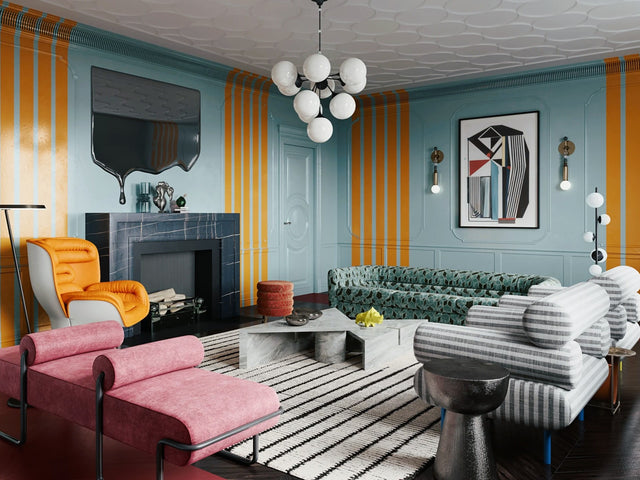POST-MODERN living inspiration!
The Postmodern Furniture Design of the 1980s
The postmodern movement emerged in the 1970s as a reaction to modernism, reaching its peak in the 1980s. Unlike modernism, which emphasized functionality and simplicity, postmodernism embraced eclecticism, irony, and a blend of different styles.
The main characteristics of Postmodern Design are eclecticism and hybridization of styles. Postmodern design combines elements from various styles and periods, creating a visually rich and often surprising mix. Irony and playfulness are expressed through unusual shapes and bold colors. Postmodernism celebrates decoration and ornamentation. It also features the use of innovative (for the time) plastic and synthetic materials, along with novel combinations of traditional and modern materials. Vibrant colors and strong contrasts are fundamental. Bold tones like magenta, turquoise, yellow, and black were common, often used in combination to create marked contrasts.
Icon of Postmodern Design
1. Memphis Group: Founded by Ettore Sottsass, the Memphis Group is perhaps the most recognizable symbol of postmodern design. Their creations, such as the Carlton bookcase, are characterized by geometric shapes, vibrant colors, and intrinsic irony.
2. Michael Graves: With his projects for Alessi and postmodern buildings, Graves brought a sense of humor and history to contemporary design.
3. Alessandro Mendini: Known for his reinterpretations of everyday objects, Mendini exemplified the playful and decorative approach of postmodernism.
Recent Trends..
In recent years, there has been a resurgence of interest in postmodern design, driven by nostalgia for the 1980s and a growing demand for expressiveness and personality in interior spaces.
1. Contemporary Reinterpretations: Many modern designers are reinterpreting postmodern design classics, maintaining their playful and colorful essence but updating them with modern materials and techniques.
2. Statement Furniture: Single furniture pieces that serve as focal points in a room, such as sculptural chairs or eccentric designer lamps, are very popular.
3. Patterns and Textures: The bold use of geometric patterns and contrasting textures has come back into fashion, often in daring and unconventional combinations.
4. Mix of Eras and Styles: Postmodern eclecticism manifests in interiors that mix vintage elements with contemporary pieces, creating a sense of history and personality.
5. Decorative Accessories: Vases, mirrors, and other decorative accessories inspired by postmodern design have become must-haves to add a touch of character and irony to interior spaces.
The postmodern furniture design of the 1980s, with its emphasis on eclecticism, irony, and decorativism, continues to influence the contemporary design world. The rediscovery and reinterpretation of this style in current trends demonstrate its lasting impact and its ability to adapt to modern tastes and needs.
Biographies's pills..
1. Ettore Sottsass (1917-2007): Ettore Sottsass was one of the founders of the Memphis Group, a postmodern design movement known for its eclectic and provocative approach. Born in Innsbruck, Austria, and raised in Italy, Sottsass became famous for his bold and colorful designs, such as the Carlton bookcase. He worked for prominent companies like Olivetti, where he designed the famous Valentine typewriter.
2. Alessandro Mendini (1931-2019): Alessandro Mendini was a designer, architect, and design theorist known for his humorous and decorative approach. He became famous for his projects that reinterpreted everyday objects, such as the Proust armchair. Mendini was the director of the magazines "Casabella" and "Domus," and collaborated with companies like Alessi, for whom he designed numerous iconic objects.
3. Michele De Lucchi (1951-): Michele De Lucchi is an Italian architect and designer, known for his work with the Memphis Group and his collaboration with companies like Olivetti and Artemide. Among his most famous works are the Tolomeo and Castore lamps. De Lucchi combined functionality and experimentation in his design approach, contributing to defining the postmodern aesthetic.
4. Matteo Thun (1952-): Matteo Thun is an Italian architect and designer, co-founder of the Memphis Group. Born in Bolzano, Thun has worked on a wide range of projects, from architecture to interior design, to product design. He has collaborated with numerous design companies and received international recognition for his innovative and sustainable approach.
5. Andrea Branzi (1938-): Andrea Branzi is an architect, designer, and design theorist, known for his work with the Archizoom Associati collective and the Alchimia group. Branzi helped redefine Italian design through his critical and experimental approach. He has written numerous books on design and has taught at various academic institutions, influencing generations of designers.
Check out our **post-modern furniture proposals** !!
Contact us for info and details!



0 Comments
There are no comments yet. Be the first one to post one!